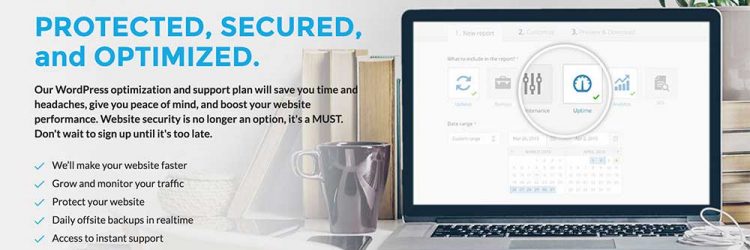
WordPress is the world’s most popular platform for creating websites, with lots of good reasons. Its popularity comes with a downside, though: It’s also the most popular platform to attack. Someone who breaks your site’s WordPress security can grab private information, alter your content, and even plant malware. Attacks like these can ruin your business’s reputation. With the right precautions, though, you can make your WordPress security very hard to breach.
The first thing is to keep your WordPress software up to date. Releases often address security issues that turned up in earlier versions. If you use a host that automatically updates your software, you’ll have no problem here. Otherwise you need to stay on top of the updates and install them as they come out. Our services keep your software up to date. Be sure to visit our WordPress Security & Optimization Package – Powered By Pressed to see how we can help with performance and protect your site.
The same applies to any themes and plugins you use. They can have weaknesses, and new releases may patch security problems. Having the latest version will give attackers the fewest chances. If updates for one stop coming out, it could be at risk.
Every theme and plugin which you install has unlimited access to your WordPress installation. Never install one from a source you don’t completely trust. Other sites might claim to offer you famous-name plugins, but you don’t know what you’re actually getting. Anything from WordPress.org should be safe, as long as it’s been recently updated. Ones that haven’t been updated in a couple of years could be risky even if they’re from a reliable source. They could have security holes or not work well with the latest WordPress release.
Don’t add plugins just because they seem nifty. Use just the ones that help your site. Each additional plugin is potentially a target. Keep it lean.
Cheap hosting sites may not include HTTPS access to your admin pages. This means that when you log in, you send your password as clear text. Someone along the data path could grab your password and gain access to your account. After that, they can do anything.
If you use the JetPack plugin and have an account on WordPress.com, you can use a single sign-on to your WordPress.com account and any WordPress sites of your own. If you have multiple sites, this saves you from having to remember a password for each of them. For extra security, you can enable two-factor authentication on WordPress.com, requiring you to confirm logins through your mobile device. A strong password plus two-factor authentication gives you good protection against theft of your credentials.
Our monthly WordPress optimization package takes care of your security and protects your WordPress website from malware intrusions and brute force attacks.
Badly designed web forms allow “unsanitized” inputs, where a malicious party can trick the software into accepting database commands. This could let an intruder read or change information in your database. A related attack is “cross-site scripting,” where a form input sneaks JavaScript into your site. It could take visitors to a malware site or display unauthorized information that seems to be from you.
Well-designed form plugins guard against sneaky inputs. Be sure to use only plugins with a reputation for good design. Badly designed ones may mean well, but they’re vulnerable to anyone who takes advantage of them.
Back up your WordPress site regularly, including the database as well as the files. If an attack compromises it, you need to be able to return to a safe state as quickly as possible. You’ll want to reinstall WordPress if an attacker may have messed with the code. Use a new password and then restore the content. Be careful to go back to the state before the attack happened, so the problem is really fixed.
A properly installed site keeps unauthorized code from getting access to its software and settings. This reduces its vulnerability to indirect attacks. If you don’t understand file protections and directory management yourself, use a hosting company that does.
If you take the necessary precautions and choose a host(us 🙂 )that takes security seriously, your site will be safe from the large majority of attacks.
Our WordPress Website optimization package protects your website from malware, provides realtime off-site backups, faster load times for SEO, 24.7 security monitoring protecting your WordPress site from malware intrusions, 24.7 Uptime monitoring, Daily WordPress plugin updates, WordPress Core Updates, and FREE weekly website reports that list your website performance, website traffic, backups, security checks, checks on all blacklistings, and uptime percentage.
